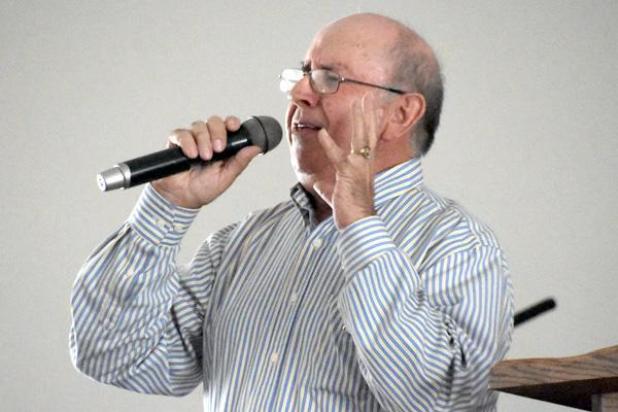
Atilano Galaviz performs at Holyoke’s First Baptist Church on Sept. 9. Galaviz, who is based in Mexico, visited the church to perform for its Spanish-language congregation. — Johnson Publications
Music important to Hispanic culture, despite limited local scene
At a Sept. 9 Sunday service, the Spanish-language congregation of First Baptist Church heard a performance by Mexican gospel singer Atilano Galaviz.
The concert was attended by about 50 people, including many children and teenagers. Although the traditional Hispanic music scene in Holyoke is limited to individual players, there exists a market and interest in the styles of Latin America, especially among the Hispanic community.
Music is an integral part of Hispanic culture, including many national and regional styles, some of which have developed in the U.S.
Today, some of the most popular genres of Spanish-language music in the U.S. include cumbia, salsa, bachata, reggaeton and corrido.
Cumbia
Cumbia is one of the most popular genres of music and dance in Latin America. The style developed in Colombia from indigenous, African and European influences. Today, it includes a galaxy of regional subgenres, like the Mexican cumbia sonidera, which is especially popular in the U.S.
Instrumentation often includes electric bass, accordion, piano, clarinet, guacharaca and assorted hand percussion. One quarter note followed by two eighth notes is called the “cumbia pattern,” and is another common feature of cumbia music.
Cumbia emerged during Colombia’s war for independence from Spain. The genre borrowed from indigenous musical traditions, as well as from the music of enslaved Africans, who had been transported to the Spanish holding of New Granada.
Over time, the genre took on characteristics from jazz and other genres of Latin music, like Cuban son and salsa. Certain traditional elements were also removed to increase its commercial appeal and make it attractive to a white, urban audience.
In the ’60s, the cumbia sound shifted away from big band toward more electric instrumentation. There is an ongoing effort to revive “traditional” Colombian cumbia, even as the genre has splintered among a number of regional styles.
Cumbia sonidera emerged in the 1990s as a distinctly Mexican twist on the genre, taking its name from the DJs, or “sonideros,” of Mexico City. In general, Mexican cumbia replaces some of the traditional cumbia instrumentation with drum set, electric bass and synthesizer.
Cumbia sonidera includes vocal interjections by DJs, organ, guacharaca and voice modulation. Other popular subgenres of Mexican cumbia include cumbia norteña and cumbia villena.
Salsa
Unlike other genres of popular Hispanic music, salsa got its start in the United States, in the barrios of East Harlem and Queens.
Salsa was born out of the music of Cuba and Puerto Rico. However, salsa is also associated with a pan-Caribbean and pan-American political identity, and is defined in part by its eagerness to incorporate musical traditions from across Latin America.
The salsa sound is dominated by hand percussion — bongos, conga and timbales are all popular in salsa groups. Bass, piano and horns are also featured. Salsa songs include an introductory section, followed by a faster portion called a “montuno” that includes improvisation and call-and-response vocals.
The full article is available in our e-Edition. Click here to subscribe.
